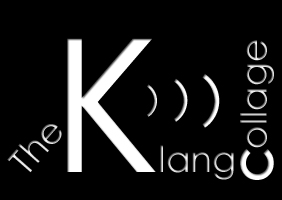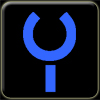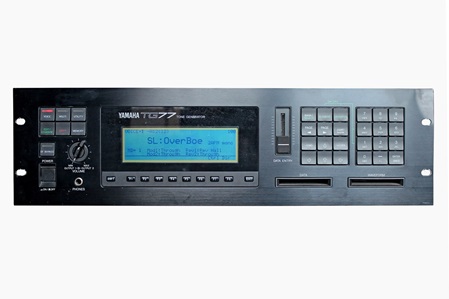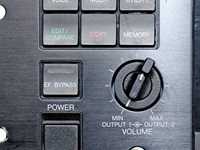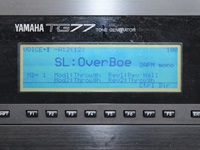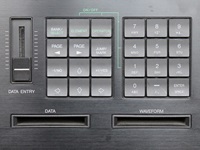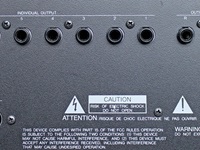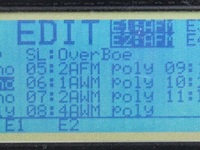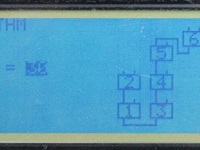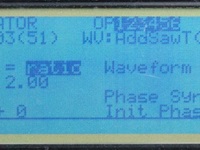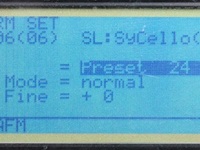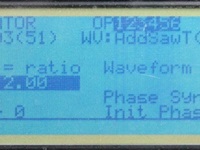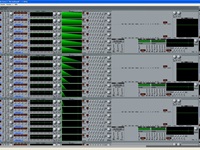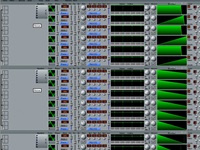RCM Hybrid Synthesis
The Yamaha TG77 was released in 1990 and it is the tone generation part of the SY77, which was released the year before, packed into a 19" rackmount unit. After the release of the DX7 in 1983, their first programmable and affordable FM synth, they brought a huge number of other FM related keyboards to the market. The DX7 had been of great commercial success (even today it is still considered to be the best selling synth ever!), so Yamaha more and more varied the technology in smaller scale products (DX9, DX21 etc), larger ones (DX1, DX5), kept it up to date in terms of technology (16 bit processing in the DX7II series) and extended its capabilities (more operator waves in TX81Z, DX11 etc). However after 7 years they probably felt they would need something new, exciting to keep the FM story alive. Because at that time another type of tone generation became more and more popular - and available: sample playback. Roland had released their D-50 synth, which used a combination of sample playback (single samples and looped waveforms) and rather basic subtractive "analog style" synthesis. Korg came with their M1, which offered "natural sounding" ;) instrument sounds based on multi-samples.
Before that FM synthesis had been considered to be able to produce the most "natural" sounds because of it´s expressiveness: the sound can be controlled and played with much more detail than with analog synths and thus it sounds more lively, similar to an acoustic instrument. However samples offered the original sound itself, so for example the piano sound of the M1 sounded much more realistic than that of a DX7. So Yamaha decided to combine their proven FM synthesis technology with sample playback to get the two worlds together. But both technologies would not simply sit side by side, but work together to influence each other. The result Yamaha called "RCM Hybrid Synthesis", where RCM stands for "Realtime Convolution and Modulation".
Since the digitalization during the 80s all manufacturers tried to invent new names for their tone generation types, which gave the impression that there was something completely new, even if there wasn´t. For example "Frequency Modulation" was new, Casio´s "Phase Distortion" was new, however the idea behind Korg´s "AI" synthesis was simply sample playback with some filtering - not a really new idea even at that time. Probably one important point about those names was to sound somewhat mystic, not immediately understandable. Well in that case Yamaha did a great job: "Realtime Convolution and Modulation" sounds amazing, while the actual meaning remains completely unclear.
So only a detailed check of the operating manual explains what they want to say: "convolution" means filtering, so here they want to stress the point, that there are filters onboard. Hey, filters in a synth - what a giant leap in synth technology ;) But in fact it was the first time that a filter was available in an FM synth. "Modulation" is quite clear, as it refers to frequency modulation, but might also be seen as a hint to the combination of sample playback and FM, which can be linked together. "Realtime" should be clear: everything is controllable in realtime. In the manual Yamaha point our the various different techniques that the SY77 / TG77 is capable of:
- analog-sytle sounds: using AWM for single cycle waveforms such as saw or square wave and feed them into the resonant filter
- DX-style sounds: the onboard AFM is an advanced form of FM with some new capabilities, but still compatible to all the classic sounds
- sample playback: this is what AWM actually is about; there are mutli-samples of the standard instruments available, from piano, strings, guitars and wind instruments to choirs, noises and effect sounds; a special type of AWM voice is the drum voice, where drum sets can be combined freely from the pool of included drum samples
- combination of sample playback with FM sounds; similar to a D-50 you can use different types of tone generation for different aspects of the sound
- FM modulated by AWM - now this is one of the really new things of the SY77 / TG77: it allows to route the sample playback engine into the FM algorythm, pretty much like an additional operator; furthermore the output of the AWM engine can be fed into the FM and to the output directly at the same time
User Interface
The TG77 comes as a 3 HU 19" rackmount unit with a fairly large LCD screen in the middle, some buttons left and right and two card slots. The stereo volume knob on the left and the data entry slider on the right are the only movable elements on the panel.
On the right it starts with the main menu buttons, effect bypass button, power on/off switch and the above mentioned volume knob. A 6.3mm stereo phone plug allows to connect a headphone directly on the front - something which would be nice on many keyboards and a must on a rackmount unit. The middle of the panel is filled with the 240 x 64 pixel LC display, which includes some soft buttons below plus shift and exit buttons. Next to the display on the right follow two button blocks. The first one is for navigation, with up/down/left/right arrows, yes/no, page back and forth plus some buttons for bank, element and operator selection. The second block is a numeric keypad, which acts as an alternative for the data entry slider. Below the two button blocks there are two card slots, one for data cards (RAM cards that can store voices, multis etc) and another one for waveform cards (ROM cards to bring in new samples).
The rear provides a stereo output, a second stereo output, 8 individual mono outputs and of course the 3 MIDI connectors (In, Out, Thru).
Sound Structure
A normal voice of the TG77 can consist of up to 4 elements. Each element is a complete sound with oscillator, filter and amp. It can be AWM or AFM, however this cannot be set freely. Instead there are a number of given configurations to choose from, which also include the monophonic or polyphonic setting:
- 1 AFM mono element - a single monophonic FM sound
- 2 AFM mono elements - two monophonic FM sounds combined
- 4 AFM mono elements - 4 monophonic FM sounds for thick layers (and also a good choice for trying additive synthesis)
- 1 AFM poly element - now this is pretty much like the old DX7, with the expanded functions of AFM compared to FM
- 2 AFM poly elements - would be the equivalent to having two DX7
- 1 AWM poly element - a standard sample playback sound with some filtering; there is no mono mode for AWM elements available
- 2 or 4 AWM poly elements - same as above, for layering or splitting sample sounds on the keyboard
- 1 AWM + 1 AFM poly elements - here you have the actual highlight, where you can route the sample into the FM algorythm
- 2 AWM + 2 AFM poly elements - same as above but 4 sounds layered or split
- Drum set - a single sample playback sound, where every key can be allocated to a sample (most probably a drum sound)
When entering the voice edit mode it is the first thing to decide for one of these configurations.
Next is the "common" area, where some basic parameters for the elements can be set. Those include volume, detune, transpose, but also note limit and velocity limit, so when using 2 or more elements, all kind of layers, splits or velocity splits are possible. Furthermore the effects, portamento and panning can be set in the "common" section. There is even a "random pitch" function, which simulates the oscillator drift of old analog circuitry.
The AFM element is the actual FM tone generator. This is 6 operator FM, where the operators can be connceted in 45 algorythms. Here we have the first advantage compared to all previous FM machines, which offered only 32 algorythms. But there is more: Originally FM in Yamaha synths worked exclusively with sine waves for the operators. For example to create a sawtooth waveform one operator´s sine wave had to modulate another one´s. With the TX81Z tone generator, shortly followed by the DX11 synthesizer Yamaha introduced the availability of other waveforms to be used in the operator. This made the system much more powerful, because now a sawtooth could be selected directly for one operator and then modulate or be modulated by another one. However the TX81Z and the DX11 both used the lighter engine with 4 operators and 8 algorythms. The SY77 and TG77 were the first products providing this capability in the larger 6 operator system. In total 16 different waveforms are available to choose from for each operator. Some of them are sound-wise very similar, just with slight differences in the high frequencies. To make the selection a bit more understandable for the user, the operating manual shows the harmonic spectrums of all waveforms, which does not really help. In pratice it is partly a game of trial and error to select the right one, as the wider choice adds another dimension of options. It opens many new possible combinations and thus makes the selection more unpredictable. A great feature, but it really needs lots of experience and you might loose yourself in endless sessions of trying different waves for carriers and modulators in a certain algorythm.
Also in previous models the algorythms included the setting of the feedback loop. There used to be one such loop and the position, which operator could be fed back into itself, was also decided by the algorythm. So that means there were several algorythms, where the setting was basically the same, just the feedback loop was on a different position. In the TG77 the feedback loop can be set freely to any operator in a selected algorythm, so the 45 algorythms offer in fact much more possibilities than 45-32=13 more. Furthermore there are 3 feedback loops available, which again offers more variations.
Each operator offers, besides the input from another modulator, two more inputs. Those can be used either for the above mentioned feedback loop or to bring in the sound from the AWM element (described below) or from the included noise generator - as well a first in FM synths.
Another advantage to previous systems is that the response of the operators to pitch modulation can be set individually by operator, so you can use for example the LFO not only for modulating the actual pitch of the sound (when routed to a carrier) but also for changes in the tonal character (when routed to a modulator). Additionally there is a so-called "sub LFO" which is in charge exclusively for pitch modulation and affects all operators the same. So when using the main LFO for other things, you can still add vibrato independently.
Then there is the digital filter. Yamaha stressed the point that it is digital, because during the 80s there were still many products on the market, which used digtal oscillators, but still analog filters. But anyway the availability of a filter in a FM tone generation was completely new, especially as FM can perform similar changes in the spectrum, so the presence of a filter was always considered as being rather obsolete. Now what can this filter do? Actually it is two filters, which can be used in different combinations:
- one filter set to LP, one to through, makes a 12dB/Oct LP filter
- both filters set to LP (can be linked together to add parameter changes to both indentically, which saves time in programming), results in a 24 dB/Oct setting
- one filter set to HP gives you a 12dB/Oct HP filter; in this case the second filter cannot be set to HP as well, which means 24dB/Oct HP is not possible
- one filter set to LP, the other to HP, results in a nice bandpass filter; again linking the parameters makes it easier to program
The filters include a resonance parameter and it proves to be useful in terms of sound. This is not a Moog ladder filter or anything similar, so don´t expect it to replace your old analog gear ;) Still it is a much better solution than for example the non-resonant version of the Korg M1. After all when you use FM, there will be most likely timbre changes resulting from the envelopes of the operators. So the filter is needed only when you want to add some classic analog-style touch to a sound.
The filter can be controlled by the same 7-segment envelope like the operators, or by scaling or LFO. Here things become quite confusing: the filters can be set to be controlled by LFO (direct control) OR envelope. That means you have to decide which one you would like to use. Using an envelope and adding some further changes by LFO is not possible. Well, actually it is, but then you have to go another way: when using the envelope for the filter, you can route the LFO through a controller such as the mod wheel or the aftertouch. And here it can be set to modulate the filter again. And there is another confusing matter: when you set the filter to envelope control, you cannot employ the mod wheel to also control the cutoff directly. Example: a classic sharp sequencer bass with a short attack envelope and while it plays, you want to change the overall cutoff by a controller (e.g. the mod wheel). Such kind of combination is not possible. Direct "live" control by a controller is only possible when the filter is set to LFO control. Understand? ;) And to make things even more complicated, the filter control by envelope comes in two variations: "EG" means that velocity changes the overall cutoff additionally to the envelope. "EG-VA" means the velocity changes the attack phase of the envelope. This basically offers certain possibilities, just the way of implementation is quite complicated, so you really have to understand the system to know its limitations.
Coming to the AWM element: naturally this is much simpler than AFM. Basically you select the (multi-)sample for the basic sound and add some pitch and amp settings. The filter is identical to that of the AFM elements and here it comes in really handy for shaping the sound and adding a dynamic dimension to the rather static samples. However the really exciting story begins, when you route the AWM to the AFM algorythm. And this does not only mean the sample sound, but the whole element including filter(s), pitch and amp settings. It is a sort of luxury operator and thus adds even more possibilities to the AFM section. It ranges from using a simple triangle wave (close enough to the sine wave of classic FM synths) without further additions to simply have a 7th operator, up to routing a detailed sample sound as a very special modulator. In practice this proves to lead to unpleasant distortion in many cases, so the input sensitivity of the operator should be set carefully and the type of sample and the location where to bring it into the algorythm should be carefully selected. Again this needs quite some experience to get useful results.
By the way it is as well possible to route the AFM signal into the AWM elemenet. In this case the AFM sound replaces the sample playback. But why would you do that? Well, in this case there are the 2 filters of the AWM section availale. So basically you can use up 4 filters for your FM sound: 2 in the AFM element plus the 2 of the AWM element. So more complex filter settings are possible, however personally I couldn´t find a reasonable use-case for this.
As an alternative to the normal voice there is a drum voice type. This can be activated by setting the voice to "drum set", which results in basically a one-element structure. Typically for a drum set every key/note can be assigned to an individual sample, mostly a drum or percussion sound. Furthermore a transpose, detune, static panning and "alternate" can be defined by key. "Alternate" means that all notes set to alternate cut off each others sustain (a closed hi-hat stopping the sound of the open hi-hat being a typical example). Basically that´s it - no filter, envelopes or anything available here, only effects can be applied as for every voice. Each key can as well be routed to an individual output, so some further processing per drum sound via a mixing desk is possible.
The TG77 does not have the sequencer, which is available on the SY77. However it includes a multi mode, so for each of the 16 MIDI channels a separate voice can be selected. For each part the volume, tuning, pan, effect, output routing etc. can be defined, however this mode clearly targets at use with an external sequencer. Complex live set-ups to be controlled from a keyboard, with layers or splits, are not available. As mentioned above those could only be achieved using the elements inside a voice.
Additive Synthesis
It might appear a bit academic, but yes, of course it is possible to perform additive synthesis on the TG77. But what is additive synthesis?
Well, it is based on the theory of French mathematician Joseph Fourier (1768-1830), which basically says that every sound consists of a mixture of sine waves (to put it this way). "Sound" we should in this case think of as a simple, static waveform, like we find them in many synthesizers oscillators: sawtooth, square etc. In return by adding up sine waves (therefore "additive synthesis") you can create such a spectrum. The sine waves, also called "partials" have to be tuned in a certain order relative to the basic pitch of the sound, following the harmonic series. It starts with a sine wave at the basic pitch, followed by a second one octave higher. The third partial (=sine wave) is a quint above the second, the next a quart higher and so on. The tonal distance between two partials becomes smaller, the higher you look into the harmonic series. Then you have to define a volume for each partial to gain a certain spectrum. To get an evolving sound with spectral changes, you need as well to specify a volume envelope for every partial. This way the sound can be changed in every possible way by fading partials in and out, theoretically extremely complex sounds are possible.
Now looking at the TG77 and basically every other FM synth we find that the operators (=oscillators) can produce sine waves (among others, but the only option in older models). And when frequency mode is set to "Ratio" we also find that the coarse tuning does not follow half notes, as you would normally expect, but the steps of the harmonic series! Obviously Yamaha found that this is the most efficient way for FM synthesis, but it also helps us in terms of additive sounds.
As we don´t want to use FM, so we need to select an algorythm that does not involve any modulation of the operators. It is there in basically every DX or other FM synth: one of the algorythms sets all available operators to carriers, meaning they don´t modulate others, but instead sit side by side. In case of the TG77 it is the algorythm number 45. Now we just need to adjust the coarse tuning of all operators according to the harmonic series, which means that operator 1 should be set to "1", number 2 to "2", 3 to "3" and so on. Next is to adjust the volume of the operators. For a standard sound the operator 1 could be set to full volume, the second a bit less and so on. This way you would get something similar to a sawtooth wave.
The problem is that the 6 operators of an AFM element are not at all enough to create a convincing spectrum, more partials and thus more operators are needed. The solution is to involve the "4 mono AFM" mode, which provides 4 AFM elements in a sound, then being monophonic. Now you can use the first elements operators for the partials 1 to 6, those of the second element for 7-12 and so on, so you get in total 24 partials. Taking into consideration that for a really detailed emulation of an existing sound by additive synthesis a couple of hundred partials are needed, 24 is not very much. However it is good enough to play around with this type of tone generation and get some insteresting sounds. And the setting of 7-stage envelopes for all 24 operators should be time consuming enough ;) By the way in older models such as the DX11 you have only 4 operators available in a voice (and no more elements), however you can employ the 8-part multimode to make up for this. By programming different voices to different areas of the harmonic series and then using them layered in the multimode (setting all multi parts to the same MIDI channel) you can even gain 32 partials. Of course in the TG77 with its 16-part multimode you could use this technique to gain 384 partials, but this would not make sense, because each operaors coarse tuning goes up only to the 31 partial.
Just to compare this approach with other dedicated systems: the Kawai K5 as well as the newer K5000 already offered up to 128 partials, while the Virsyn Cube provides up to 512. However the K5 was a nightmare to program (you have to make settings for all 128 partials separately) and the Cube as a VST software offers to literally draw a spectrum or, since version 2, use resynthesis, which means you input a sample and leave the settings of volume and envelopes of all partials to the analysis algorythm.
For programming the TG77 I use the good old Emagic Sound Diver software, a great remote editor, which is unfortunately not available any more. After Apple bought Emagic they obviously considered this editor for old MIDI gear not worth to continue and rather concentrated on the DAW Logic. Still the software works nice, if you have computer running the older WinXP or Mac OS 9.x. Especially for additive synthesis it is extremely useful, as you can see all the volumes and envelopes one below the other and you can quite easily copy, paste and modify settings among all operators.
